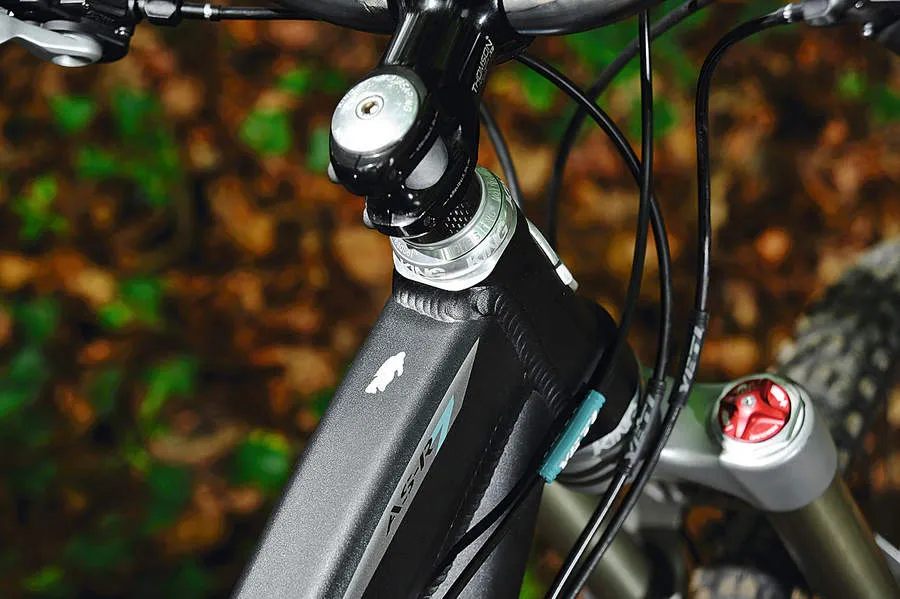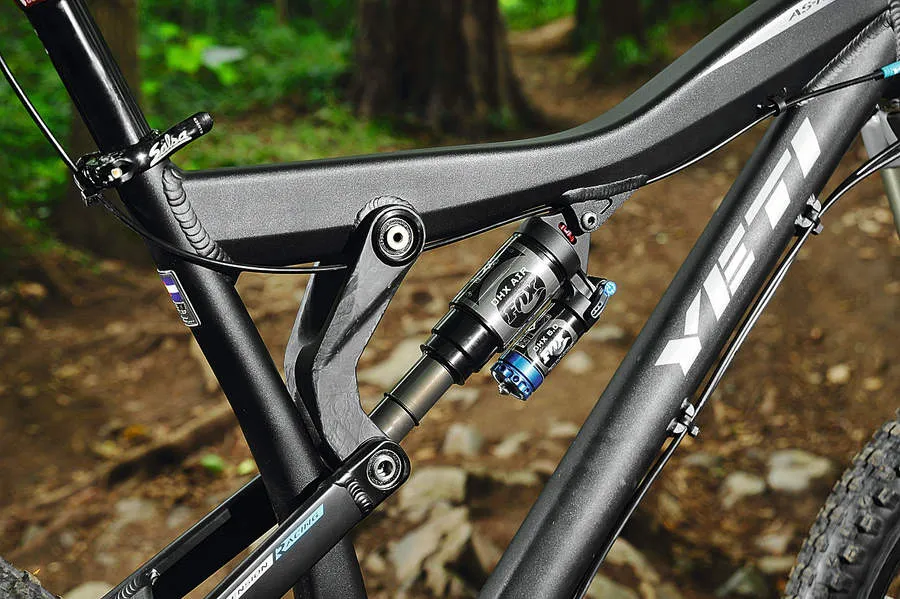This longer travel (7in) sibling of Yeti’s super-popular 575 trail bike has been a long time in development. In construction terms it’s not as radical as the first prototypes we saw, but there’s been no compromise of its ‘big country’ ride character.
If you’re looking for a hop-and-drop playbike, the long, super-stable and tall Yeti isn't the ideal option. Add an adjustable seatpost and get yourself to some properly big and open, frighteningly fast descents, however, and it comes into its own. Its length and good pedalling manners also make reloading the gravity fun gun a lot easier than on most comparable bikes.
Ride & handling: Serious big mountain machine that's at home on wide open descents
The last Yeti with as much travel as this was the Freeride AS-X with a short, burly frame designed specifically for long-drop lunacy. Despite the similarities in travel, the ASR 7 couldn’t be more different in design intent.
This is obvious as soon as you’re on board: even the medium frame comes with a long, cross-country style reach and the 19in seat tube means noticeably less standover if you have to straddle it in an emergency.
The long wheelbase and slack head angle also make it a bike you have to drive round stuff rather than cutting it close or popping it round.
On the first run out with a standard seatpost we realised we couldn’t lower the saddle enough to be confident launching drops that we’d otherwise have been straight off, given the travel and category of bike. As Yeti say, though, this isn’t that sort of ‘shoot from the hip’ playbike – it’s a serious big mountain machine.
Faced with a long climb, the length that dogs it on tighter trails becomes very welcome breathing space to offset the 31lb weight. Even with the shock running soft, a quick flick of the ProPedal platform damping lever gives solid power delivery for grinding up gradients.

The Yeti will winch up almost anything you can keep the pedals turning on – often to the annoyance of riders who’ve fluffed the same sections on far lighter, shorter travel bikes.
It’s when you get to the top of a properly big climb and start heading down the other side that the ASR 7 really starts to make sense. Tight craggy switchbacks and steps aren’t where this bike shines; instead it totally rules in exactly the kind of wide open descents where super-agile bikes tend to soil themselves.
Whether it’s sweeping cat litter corners or random baby head rocks underneath you, it’s totally assured and confident.
The big carbon linkage and deep chainstays minimise rear wheel twist and yaw when you’re really bending it sideways against terrain or directional inertia. Once you’ve got a droppable post in there it’s nicely poised for launching the big stuff too, although that long back end means you have to carry a bit more speed and project each launch a bit further than normal.
The dogbone suspension linkage manages the notoriously hard-to-settle Fox DHX Air shock really well, adding genuine control and purpose to the middle of the stroke. That said, the stock RP23 shock is the option we’d probably go for.
In more stop/go sections the full 7in (178mm) of rear wheel travel means brake jack rarely disturbs composure, and the fast-reacting Crossline freehub will engage pedalling instantly anywhere in the stroke – a welcome change from more pedal-referenced bikes which have to pull their trousers up to a predetermined sag point before they really start driving.

Frame: Suitably burly chassis, but interrupted seatpost means it's worth getting an adjustable post
The ASR’s front end is conventionally contemporary. A tapered 1-1/2 to 1-1/8in head tube lets you use the latest light-but-tight fork steerer technology (or your current 1.125in fork with the appropriate reducer cup).
The multi-faceted top tube tapers from both ends towards the central shock mount with the pivot for the big carbon fibre ‘dogbone’ linkage also hanging below.
The seat tube is kinked back from halfway up too, with a machined block cut into the bottom end where it meets the bottom bracket shell.
It looks sweet but there are some practical issues you need to think about. The big, shaped down tube carries the straight-through cable routing and rear brake hose exactly where you’re likely to get rocks flicking up from the front wheel.
This helps protect the frame itself and you’re highly unlikely to get a cable severed or a split hose, but the speed at which this bike can scream down rocky descents means we’d probably protect them with an old bit of tyre just in case.
A combination of the large 19in frame (medium size) and the kinked seat tube that prevents full post drop makes a height-adjustable seatpost essential for big drops. The top tube is clipped and ready for a remote control cable, though.

Things have deinitely calmed down out back: the first ASR 7 frames we saw were rocking various radical carbon fibre rear ends, including asymmetric single chainstay arrangements, custom 12mm axle dropouts and even hidden helper linkages.
While Yeti say they were totally happy with the design and had invested heavily in moulds and tooling, the company were concerned that a carbon rear end would undermine people’s confidence in the bike.
As a result, production bikes have come through with a monolithic looking slab-sided alloy rear end made from tapered rectangular and square-section pieces. Low triangular dropouts carry the seatstay pivots on their top corner and a clamp-in 12mm rear axle locks on the rear wheel.
A CNC-machined chainstay yoke and high-set seatstay bridge mean you can run monster 2.5in tyres if you want, and the gear cable and brake hose run neatly along the chainstay top. Again we’d get a chainguard in place to protect the gear wire.
Finally, you’ve got a choice of the black anodised version you see here, or pure white powder coat or classic Yeti turquoise mainframe, both with an anodised black rear end.
Tester says...
"The first ride on the Yeti was a disappointment. It’s just too big for technical terrain and the lack of seat drop saw it baulk at the big drops. When I changed to big, open quarry road climbs and descents, it all started to make sense. You need some big hills, and big balls, to really do it justice."


